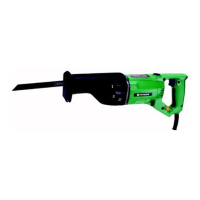5
English
HOW TO USE
CAUTIONS
䡬 Do not remove the insulation cover. It is necessary
to support the body of the tool.
䡬 During operation, the base of the tool should be
pressed against the material, as shown in Fig. 6,
herein. If the tool is not properly pressed against
the maerial, the blade may be damaged by vibration.
1. Cutting metallic materials
Ensure the material is firmly held in position during
operation. Always use an appropriate cutting agent
(spindle oil, soapy water, etc.). When a liquid cutting
agent is not available, apply grease to the material
to be cut.
2. Cutting lumber
When cutting lumber, ensure that the wooden
material is firmly fixed in position.
3. Sawing curved lines
Use a No. 6 or No. 7 blade (optional accessories)
as described below.
䡬 For metal-working - No. 6
䡬 For wood-working - No. 7
When sawing a small circular arc, reduce the feeding
speed of the machine.
4. Cut off guide for cutting pipe (optional accessory)
NOTE
Please refer to the cut off guide user’s manual for
details on how to use ti correctly.
SELECTION OF BLADES
To ensure maximum operating efficiency and results, it
is very important to select the appropriate blade best
suited to the type and thickness of the material to be cut.
Three types of blades are provided as standard
accessories.
The blade number is engraved in the vicinity of the
mounting position of each blade. Select appropriate
blades by refering to Tables 1 and 2 below.
Table 1
Product
Cutting Blade Applicable
Code No.
application
used products
Cut-off Outer diameter
Model CR10V 984449
guide (L)
75mm – 175mm
No. 9
Model CR12,
CR12V
996420
Cut-off Outer diameter
Model CR10V 984448
guide (S) 10mm – 55mm
No. 1
Model CR12,
996429
CR12V
NOTE
No. 2, No. 4, No. 6, No. 7, No. 8, No. 9, No. 95,
and No. 96 blades are sold separately.
For other materials.
Table 2
MAINTENANCE AND INSPECTION
1. Inspecting the blade
Continued use of a dull or damaged blade will
result in reduced cutting efficiency and may cause
overloading of the motor. Replace the blade with
a new one as soon as excessive abrasion is noted.
2. Inspecting the mounting screws:
Regularly inspect all mounting screws and ensure
that they are properly tightened. Should any of the
screws be loose, retighten them immediately. Failure
to do so could result in serious hazard.
Blade
Uses
Thickness
No. (mm)
No.1
For cutting steel pipe less
than 115mm in diameter
2.5 – 6
No.2
For cutting steel pipe less
than 40mm in diameter
2.5 – 6
No.3
For cutting steel pipe less
than 40mm in diameter
Below 3.5
Blade
Uses
Thickness
No. (mm)
No.4
For cutting and roughing
lumber
50 – 100
No.5
For cutting and roughing
lumber
Below 50
No.6
For sawing curved lines
iron plate
Below 3.5
No.7
For sawing curved lines
lumber
Below 30
No.8
For cutting vinyl chloride
pipe less than 115mm in
diameter
2.5 – 15
For cutting and roughing
lumber
Below 50
No.9
For cutting mild steel pipe
less than 175mm in diameter
when used with cut off guide
2.5 – 6
No.95
For cutting stainless steel
pipe less than 115mm in
diameter
Below 2.5
No.96
For cutting stainless steel
pipe less than 40mm in
diameter
Below 2.5
Material
Material quality
Thickness Blade
to be cut (mm) No.
Iron plate Mild steel plate
Below 3.5 No.3,6
2.5 – 12 No.1,2
Nonferrous Aluminium, Below 5 No.3,6
metal Copper, Brass 5 – 20 No.1,2
Synthetic
Phenol resin,
restin
Melamine
5 – 30 No.3,5,8
resin, etc.
10 – 50 No.1,2,4,
Vinyl chloride 5 – 30 No.3,5,8
Acrylic resin, etc. 10 – 60 No.1,2,4

